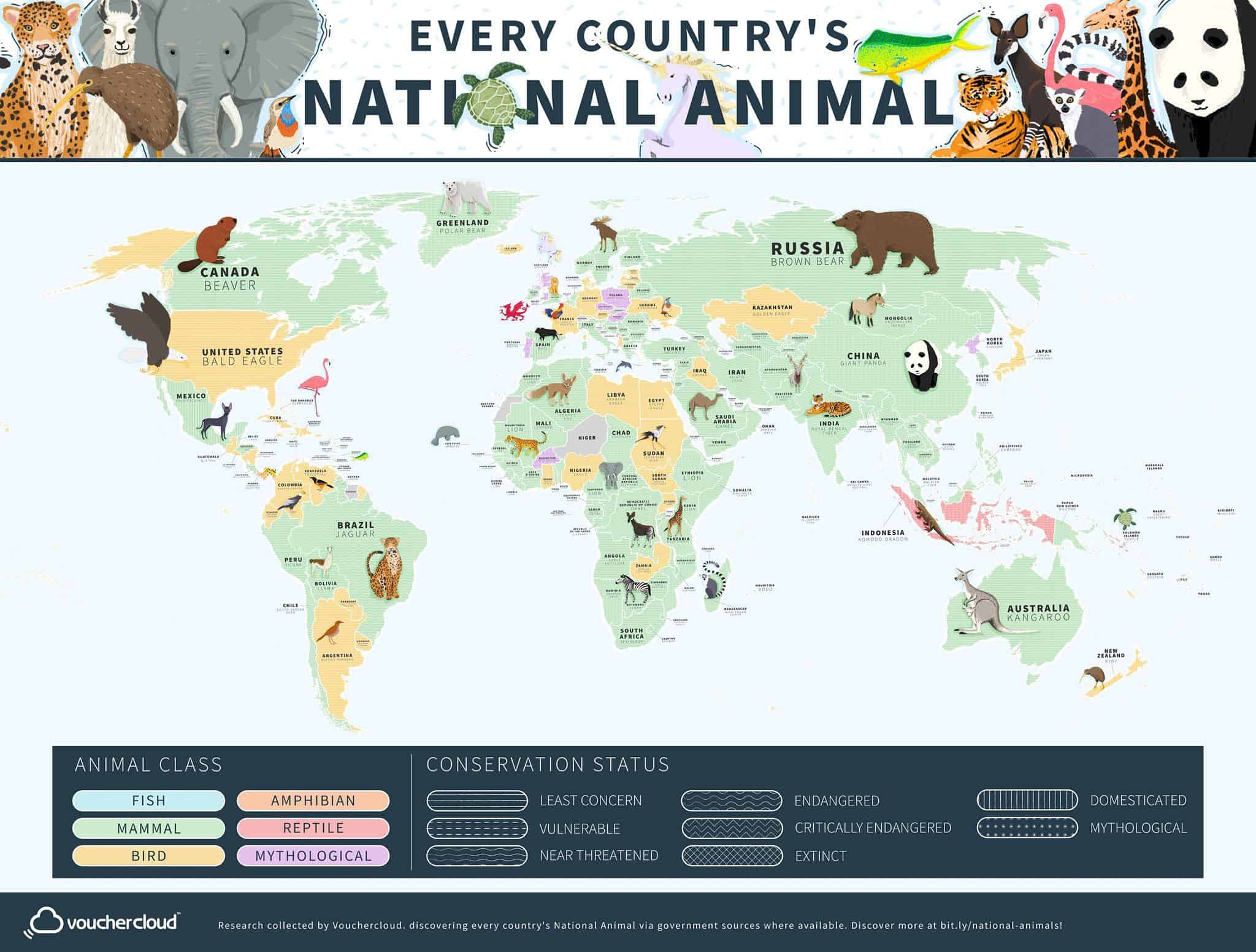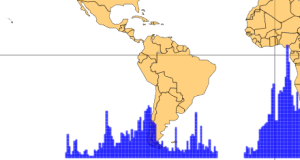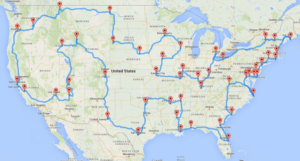Animals are adorable! Who can argue with that? All the countries in the world seem to agree—they use all kinds of animals as their national symbols. Almost every country in the world has an official national animal, and some have more than one.
America’s bald eagle is one of the most widely known national animals. Canada has two national animals: the well-known beaver, and also the lesser-known Canadian horse (that is not even on the map below).
Some countries even choose mythological creatures as their national animals: Wales* has the dragon; Scotland* has the unicorn; and Singapore went even further and designed a new animal, the Merlion, which is half fish half lion.
*Scotland and Wales are “countries”, but not “sovereign states”: we’ll explain the difference in a future article
Let’s take a look at the map, the most common types of national animals, and which among them stand out.
The Map
For an overview of all the national animals, Vouchercloud designed a map with every country’s national animal and its conservation status.

You can see the full-size version to read the small print.
Just by looking at all the green on the map, it’s quite apparent that mammals dominate the list, because yes, the map is color-coded:
- green for mammals
- yellow for birds
- red for reptiles
- blue for fish
- orange for amphibians
- purple for mythological creatures
Let’s take a look at the numbers for each:
- 120 mammals (65%)
- 52 birds (28%)
- 7 mythological creatures (4%)
- 3 reptiles (2%)
- 2 fish (1%)
- 1 amphibian (<1%)
The map also shows the conservation status of the animals: if you zoom you’ll see the patterned backgrounds. You’ll notice that more than 30 of the national animals are extinct or critically endangered, and more than 40 are considered vulnerable.
National Animals That Stand Out
Some national animals are surprising since they aren’t typical symbols of their countries at all.
In Europe, for example, several countries use the lion as their symbol, even though it’s not a particularly lion-heavy part of the world.
The lion is so popular, in fact, that it’s now the national animal for 19 different countries (it’s by far the most common one).
Other national animal symbols are often part of a country’s attempt to create a visual representation of its people’s goals, values, and history and are very emblematic, while others are just unique and we’ll look at these by category.
Particularly Emblematic Animals
Some national animals are well-recognized symbols of their countries, such as:
- Beaver (Canada)
The beaver represents the fur trade in Canada, which dates back to 1621 when the Hudson’s Bay first put the animal on its coat of arms. The Canadian horse joined the beaver as a national animal in 2002. - Bald Eagle (USA)
The Founding Fathers selected the bald eagle to represent their new nation in 1782 as a symbol of strength and freedom. - Kangaroo (Australia)
It is thought that Australia chose the kangaroo because of its inability to move backward well, so this animal signifies moving forward as a nation. - Royal Bengal Tiger (India)
Along with being found throughout most of India, the Royal Bengal Tiger represents the strength, elegance, alertness, intelligence, and endurance of the nation. - Giant Panda (China)
Pandas are self-sufficient, and as a symbol, can be associated with bringing abundance and prosperity.
Mythological Animals
- Unicorn (Scotland)
Since the 12th century, the unicorn has been a Scottish heraldic symbol. In Celtic mythology, it symbolizes innocence, purity, the power of healing, joy, and life. And it’s also a symbol of masculinity and power. - Chollima (North Korea)
The Chollima (or the thousand-mile horse) symbolizes heroism, the constant fighting spirit of the Korean people, and rapid innovation and progress at the speed of Chollima. - Red Dragon (Wales)
Dating back to the 5th century, the Welsh kings used the image of a dragon to symbolize their power and authority after the departure of the Romans. Historically, the dragon is also associated with the legends of King Arthur and the story of Merlin’s prophecy of a long battle between the red and white dragons, symbolizing the historical friction between the Welsh and English. - Barcelo Rooster (Portugal)
The Barcelo Rooster is one of Portugal’s most common symbols. The legend behind this national animal tells the story of a dead rooster who came back to life and proved the innocence of a wrongly accused man. - Double-tailed Lion (Czechia)
There are many different stories behind the double-tailed lion, but one of the most popular is that the second tail represents Moravia, which is another part of Czechia besides Bohemia. - White Eagle (Poland)
According to the legend, Poland’s mythical founder, Lech, was traveling around Poland, when he ran into a nest of a majestic white eagle. The great bird spread its massive wings across the setting sun’s red rays, creating an inspiring sight for Lech. He later established the first city Gniezno (“nest” in Polish), and adopted the white eagle as its symbol. - Turul (Hungary)
The Turul is the most remarkable bird to appear in Hungarian mythology. The Turul is considered a protector spirit and a symbol of power, authority, and dignity.
Reptiles
- Komodo Dragon (Indonesia)
The Komodo dragon is the world’s largest type of lizard, and it can only be found in the Indonesian islands. - Crocodile (Timor-Leste)
To the people of Timor-Leste, crocodiles are sacred animals. According to the myth, the crocodile Lafaek Diak sacrificed itself for a boy with whom it had a friendship and became the boy’s home: the island of Timor. Each bump on the crocodile’s back grew into a mountain. - Turtle (Solomon Islands)
Turtles have always played a significant role in the village life of Solomon Islands, both in terms of food and money. The oldest archeological sites with turtle bones date back 3000 years.
Amphibians
- Golden Frog (Panama)
The golden frog of Panama is a widely popular symbol for good luck. Sadly, it’s believed that the golden frog has gone extinct.
Fish
- Yellowfin Tuna (Maldives)
Yellowfin Tuna is one of the most important species for the Maldivian fishing industry, which is how much of the population on this island makes a living. - Mahi-mahi (Barbados)
Mahi-mahi is a dolphinfish, which symbolizes playfulness, calmness, and intelligence. It’s also the fastest-growing fish in the world.
Mammals
- Xoloitzcuintli (Mexico)
The Xoloitzcuintli, or Mexican Hairless Dog, is one of the most unusual dog breeds in the world. The name derives from the Aztec words “Xolotl” (meaning God of lightning and death) and “itzcuintli” (meaning dog). Legend has it that the dog was gifted to humankind by Xolotl to guide them through life. - Manatee (Cabo Verde)
Manatees are large marine mammals that stand as a symbol of calmness, gentleness, and grace.
Birds
- Black Eagle (Germany):
Germany’s national bird, the black eagle, is a symbol of wisdom, self-discipline, victory, and independence. - Flamingo (Bahamas):
Flamingos are incredibly beautiful, rare, and unique birds. As the national animal of the Bahamas, it represents colorfulness, beauty, and elegance.
Do you want to get more cool maps like this in your inbox?
Summary
Most of these national animals represent or symbolize some aspect of each country. Whether it’s a symbol of beauty, independence, good fortune, or some other mythological reason, we can learn a lot from the national animals of each country.
Is there a country you’ve visited that has a cool national animal? Which national animal are you surprised to learn about? Share with us in the comments below!
Want to see our current discounted plane tickets?
Click here to see our flight deals
Want more travel tips and inspiration?
Click here to see the blog homepage
You’ll probably enjoy this article:
Travel Hacking: Free Travel (really)
Help us spread the word about our flight deals and travel tips by sharing this article and, most importantly, bookmark Flytrippers so we can help you navigate the world of low-cost travel!
Featured image: Every Country’s National Animal Map (Photo Credit: Vouchercloud)
Advertiser Disclosure: Flytrippers receives a commission on links featured in this blog post. We appreciate it if you use them, especially given it never costs you anything more to do so, and we thank you for supporting the site and making it possible for us to keep finding the best travel deals and content for you. In the interest of transparency, know that we will NEVER recommend a product or service we do not believe in or that we do not use ourselves, as our reputation and credibility is worth far more than any commission. This principle is an essential and non-negotiable part of all our partnerships: we will never give any third-party any control whatsoever on our content. For more information on our advertiser disclosure, click here.




